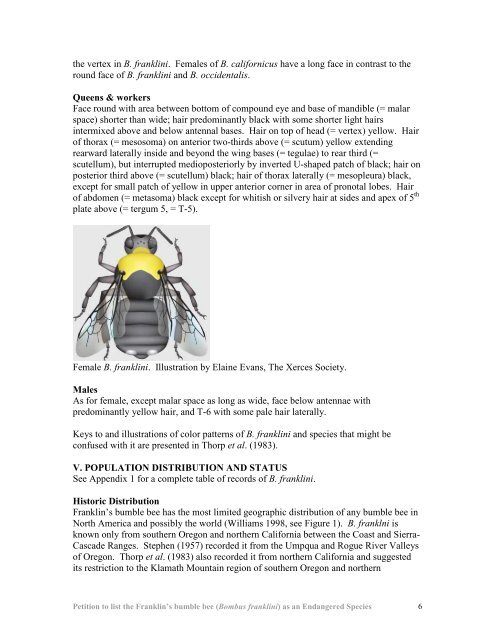Franklin's bumble bee - The Xerces Society
Franklin's bumble bee - The Xerces Society
Franklin's bumble bee - The Xerces Society
Create successful ePaper yourself
Turn your PDF publications into a flip-book with our unique Google optimized e-Paper software.
the vertex in B. franklini. Females of B. californicus have a long face in contrast to the<br />
round face of B. franklini and B. occidentalis.<br />
Queens & workers<br />
Face round with area between bottom of compound eye and base of mandible (= malar<br />
space) shorter than wide; hair predominantly black with some shorter light hairs<br />
intermixed above and below antennal bases. Hair on top of head (= vertex) yellow. Hair<br />
of thorax (= mesosoma) on anterior two-thirds above (= scutum) yellow extending<br />
rearward laterally inside and beyond the wing bases (= tegulae) to rear third (=<br />
scutellum), but interrupted medioposteriorly by inverted U-shaped patch of black; hair on<br />
posterior third above (= scutellum) black; hair of thorax laterally (= mesopleura) black,<br />
except for small patch of yellow in upper anterior corner in area of pronotal lobes. Hair<br />
of abdomen (= metasoma) black except for whitish or silvery hair at sides and apex of 5 th<br />
plate above (= tergum 5, = T-5).<br />
Female B. franklini. Illustration by Elaine Evans, <strong>The</strong> <strong>Xerces</strong> <strong>Society</strong>.<br />
Males<br />
As for female, except malar space as long as wide, face below antennae with<br />
predominantly yellow hair, and T-6 with some pale hair laterally.<br />
Keys to and illustrations of color patterns of B. franklini and species that might be<br />
confused with it are presented in Thorp et al. (1983).<br />
V. POPULATION DISTRIBUTION AND STATUS<br />
See Appendix 1 for a complete table of records of B. franklini.<br />
Historic Distribution<br />
Franklin’s <strong>bumble</strong> <strong>bee</strong> has the most limited geographic distribution of any <strong>bumble</strong> <strong>bee</strong> in<br />
North America and possibly the world (Williams 1998, see Figure 1). B. franklni is<br />
known only from southern Oregon and northern California between the Coast and Sierra-<br />
Cascade Ranges. Stephen (1957) recorded it from the Umpqua and Rogue River Valleys<br />
of Oregon. Thorp et al. (1983) also recorded it from northern California and suggested<br />
its restriction to the Klamath Mountain region of southern Oregon and northern<br />
Petition to list the Franklin’s <strong>bumble</strong> <strong>bee</strong> (Bombus franklini) as an Endangered Species 6
















